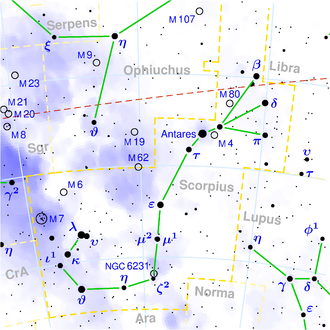Jubba
|
Double star Jubba (δ Scorpii) |
|||||||||||||||||||||||
|---|---|---|---|---|---|---|---|---|---|---|---|---|---|---|---|---|---|---|---|---|---|---|---|
| AladinLite | |||||||||||||||||||||||
|
Observation dates equinox : J2000.0 , epoch : J2000.0 |
|||||||||||||||||||||||
| Constellation | Scorpio | ||||||||||||||||||||||
| Right ascension | 16 h 00 m 20 s | ||||||||||||||||||||||
| declination | -22 ° 37 ′ 18 ″ | ||||||||||||||||||||||
| Apparent brightness | 2.32 (1.59 to 2.32) mag | ||||||||||||||||||||||
| Typing | |||||||||||||||||||||||
| B − V color index | (−0.12) | ||||||||||||||||||||||
| U − B color index | (−0.90) | ||||||||||||||||||||||
| R − I index | (−0.13) | ||||||||||||||||||||||
| Spectral class | B0.3 IVe / B3: V | ||||||||||||||||||||||
| Variable star type | GCAS | ||||||||||||||||||||||
| Astrometry | |||||||||||||||||||||||
| parallax | (6.64 ± 0.89) mas | ||||||||||||||||||||||
| distance | (490) ly (150) pc |
||||||||||||||||||||||
| Proper movement | |||||||||||||||||||||||
| Rec. Share: | (−10.21 ± 1.01) mas / a | ||||||||||||||||||||||
| Dec. portion: | (−35.41 ± 0.71) mas / a | ||||||||||||||||||||||
| Physical Properties | |||||||||||||||||||||||
|
Other names and catalog entries |
|||||||||||||||||||||||
|
|||||||||||||||||||||||
Jubba (from the Arabicجبهة, DMG ǧubha 'forehead') is the name of the star Delta Scorpii (δ Scorpii) in the constellation Scorpio . Dschubba has an apparent brightness of +2.29 mag and belongs to the spectral class B0. Jubba is about 490 light years away. Other spelling and names: Dzuba, Iclarcrau, Iclarkrav.
As a star near the ecliptic, Jubba can be covered by the moon and (very rarely) by planets several times per decade .
He played an important role in 1981 in the study of Saturn's rings : When Voyager 2 flew away from Saturn, the probe was at a occultation by the planet and its over 100,000 km wide ring system continuous brightness measurements perform. The starlight was attenuated by the ring as expected, shining through several well-known gaps between them such as the 6,000 km wide Cassini division . The only 300 km narrow Encke division on the outer edge of the bright A-ring showed that this gap is not entirely free of ring particles. Two thin, eccentric particle rings could be detected with an exactly matching cycle time of 13.82 h.
